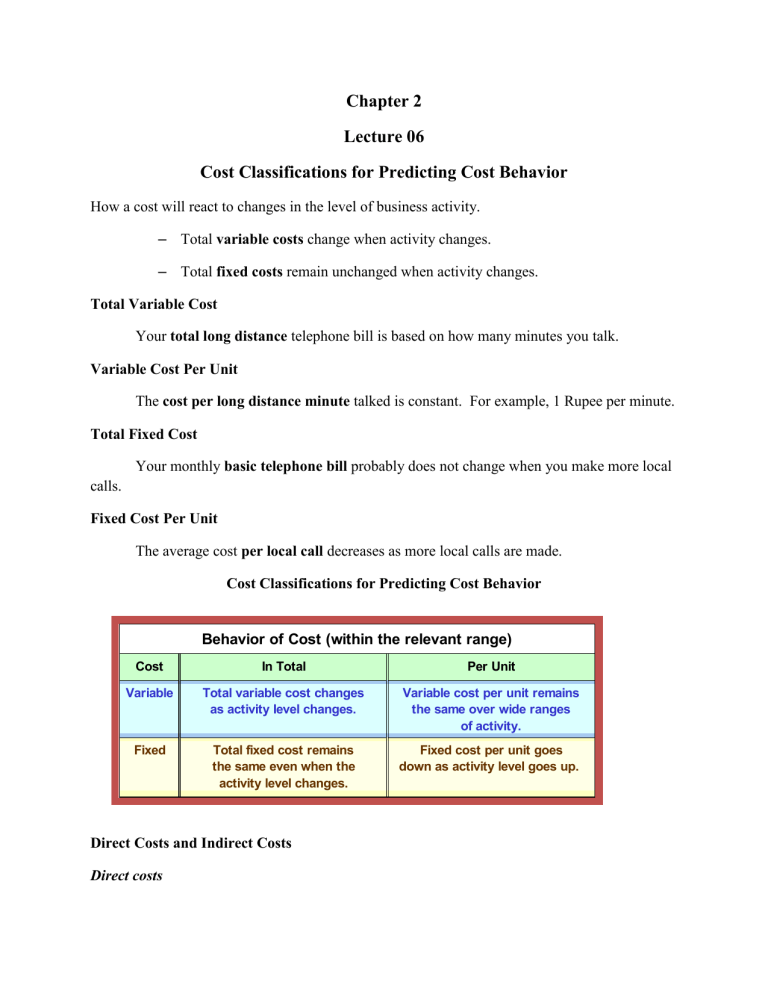Chapter 2

Chapter 2
Lecture 06
Cost Classifications for Predicting Cost Behavior
How a cost will react to changes in the level of business activity.
–
Total variable costs change when activity changes.
–
Total fixed costs remain unchanged when activity changes.
Total Variable Cost
Your total long distance telephone bill is based on how many minutes you talk.
Variable Cost Per Unit
The cost per long distance minute talked is constant. For example, 1 Rupee per minute.
Total Fixed Cost calls.
Your monthly basic telephone bill probably does not change when you make more local
Fixed Cost Per Unit
The average cost per local call decreases as more local calls are made.
Cost Classifications for Predicting Cost Behavior
Cost
Variable
Fixed
Behavior of Cost (within the relevant range)
In Total
Total variable cost changes as activity level changes.
Total fixed cost remains the same even when the activity level changes.
Per Unit
Variable cost per unit remains the same over wide ranges of activity.
Fixed cost per unit goes down as activity level goes up.
Direct Costs and Indirect Costs
Direct costs
•
Costs that can be easily and conveniently traced to a unit of product or other cost objective.
•
Examples: direct material and direct labor
Indirect costs
•
Costs cannot be easily and conveniently traced to a unit of product or other cost object.
•
Example: manufacturing overhead
Differential Costs and Revenues
Costs and revenues that differ among alternatives
Example: You have a job paying $1,500 per month in your hometown. You have a job offer in a neighboring city that pays $2,000 per month. The Transportion cost to the city is $300 per month.
Opportunity Costs
The potential benefit that is given up when one alternative is selected over another. Example: If you were not attending college, you could be earning $15,000 per year. Your opportunity cost of attending college for one year is $15,000.
Sunk Costs
Sunk costs cannot be changed by any decision. They are not differential costs and should be ignored when making decisions.
Example: You bought an automobile that cost $10,000 two years ago. The $10,000 cost is sunk because whether you drive it, park it, trade it, or sell it, you cannot change the $10,000 cost.
End of Lecture 06
Lecture 06
Cost
Sacrifice made to achieve a particular purpose measured by the resources given up.
Product cost
A cost assigned to goods that were either purchased or manufactured for resale purpose
Cost of goods sold
In the period of sale, the product costs are recognized as an expense called cost of goods sold
Period cost
Costs are identified with the period of time in which they are incurred.
Manufacturing Costs
Direct Material
Raw Material, can be traced out in finished products
Direct Labor
Salaries, wages, fringe benefits for people directly working on production
Manufacturing Overheads
Indirect material
Insignificant to trace i.e. Cost of drill bits, glue, nails,
Indirect labor
Deptt supervisors, security guards etc
Manufacturing overheads.
Depreciation of plant and machinery, property taxes, insurance, electricity, gas etc.
Prime Cost
–
This includes the material and direct labor
Conversion Cost
–
This includes the direct material and factor overheads
Sample Income Statement of Manufacturing Company
Sample Income Statement of Bank
End of Lecture 07
Lecture 08
Exercise Questions
Sales revenue
Work-in-process inventory, December 31
Rs. 950000
30000
Work-in-process inventory, December 01
Selling and administrative expenses
40000
150000
Income tax expense
Purchase of raw material
Raw-material inventory, December 31
Raw-material inventory, December 01
40%
180000
25000
40000
Direct labor
Utilities, plant
Depreciation: plant and equipment
200000
40000
60000
Finished goods inventory, December 31
Finished goods inventory, December 01
Indirect material
Indirect labor
Other manufacturing overhead
50000
20000
10000
15000
80000
Beginning Inventory, raw Material
Ending Inventory, raw Material
Purchase of Raw Material
Direct Material
Direct Labor
Manufacturing Overhead
Total Manufacturing Cost
Beginning Inventory, work in process
Ending Inventory, work in process
Cost of Good Manufactured
Beginning Inventory, finished goods
Cost of Goods available for Sale
Ending Inventory, finished goods
Cost of Goods Sold
Sales
Gross margin
Selling and admin expenses
Income before taxes
Income tax expense
Net income
End of Lecture 08
Case A
?
Rs. 90000
100000
70000
?
250000
520000
35000
?
525000
50000
?
?
545000
?
255000
?
150000
40000
?
Case B Case 3
Rs. 20000 Rs. 15000
?
30000
85000 ?
95000
100000
?
395000
?
125000
160000
340000
20000
35000
?
40000
?
?
33000
?
170000
75000
?
45000
?
?
90000
?
55000
?
5000
350000
?
370000
25000
?
480000
?
Lecture 09
Exercise Questions
Q No. 1
Requirements
1.
Calculate Lone Oak’s manufacturing overhead for the year
2.
Calculate Lone Oak’s cost of goods manufactured
3.
Compute Cost of goods sold
4.
Determine net income. Assuming 30% income tax
5.
Determine number of completed units manufactured during the year.
Q No. 2
•
On April 12, after the close of business, Unilever had a devastating fire that destroyed the company’s work in process and finished goods inventories.
•
Fortunately, all raw materials escaped damage because material owned by the firm was stored in another warehouse.
•
The Firms accountant determined that the cost of direct materials used normally averages
25 percent of prime costs. In addition, manufacturing overhead is 50 percent of the firm’s total production costs.
Sales revenue through April 12 $330000
Income before taxes through April
Direct Labor Through April 12
Cost of Goods Available for Sale, April 12
68000
120000
275000
Work in process inventory, January 1
Finished goods inventory, January 1
21000
37000
Gross Margin 30% of Sales
Requirement: Unilever is in the process of negotiating a settlement with its insurance company.
Prepare an estimate of the cost of work in process and finished goods inventories that were destroyed by the fire.
End of Lecture 09



